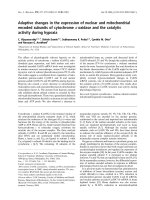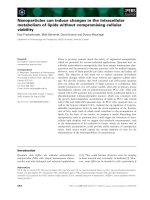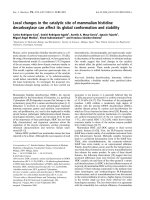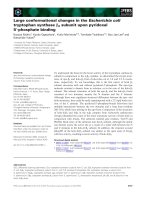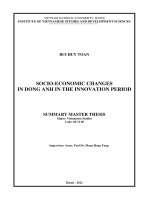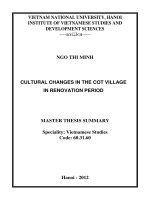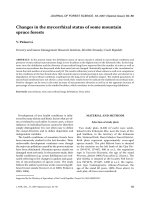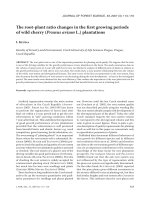Socio-economic changes in Dong Anh in the innovation period
Bạn đang xem bản rút gọn của tài liệu. Xem và tải ngay bản đầy đủ của tài liệu tại đây (2.39 MB, 98 trang )
VIETNAM NATIONAL UNIVERSITY, HANOI
INSTITUTE OF VIETNAMESE STUDIES AND DEVELOPMENT SCIENCES
BUI HUY TOAN
SOCIO-ECONOMIC CHANGES
IN DONG ANH IN THE INNOVATION PERIOD
MASTER THESIS
Major: Vietnamese Studies
Hanoi - 2012
2
VIETNAM NATIONAL UNIVERSITY, HANOI
INSTITUTE OF VIETNAMESE STUDIES AND DEVELOPMENT SCIENCES
BUI HUY TOAN
SOCIO-ECONOMIC CHANGES
IN DONG ANH IN THE INNOVATION PERIOD
MASTER THESIS
Major: Vietnamese Studies
Code: 60 31 60
Supervisor: Assoc. Prof Dr. Pham Hong Tung
Hanoi - 2012
1
PROMISE
The subject: Socio-economic changes in Dong Anh in the innovation
period, is a research of major socio-economic changes in Dong Anh District in
innovation period (especially since 2000). The sources of materials used in the
thesis are the secondary and the primary. The sources of primary materials are
quoted with clear notes to ensure objectiveness of materials and copyright. This
thesis is not similar to any work of socio-economic study in Dong Anh district in
the previous time. Argumentations and scientific conclusions as stated and the
sources of materials collected in the thesis are objective and honest and
completed with efforts of the author of the thesis and the orientations of the
instructor.
MA Student
Bui Huy Toan
2
ACKNOWLEDGEMENT
My MA thesis has been completed with supports from many organizations
and individuals.
I would like to give my sincere thanks to lecturers of Institute of Vietnamese
Studies and Development Sciences, Vietnam National University, Hanoi, who
facilitated and provided me with knowledge during study process in the
Institute.
I would like to express my heartfelt thanks to Dong Anh District People’s
Committee and Divisions for facilitating and helping me to collect materials
for my thesis!
Especially, I would like to show my deep gratitude Assoc. Prof Dr. Pham
Hong Tung, who gave advices to and encouraged me during the research.
I would like to manifest my thanks to my family, close relatives, friends and
members of Vietnamese Studies MA Class of 5
th
, who have always encouraged
and shared with me many things during study.
Hanoi, ……. February, 2012
MA Student
Bui Huy Toan
3
TABLE OF CONTENTS
INTRODUCTION 5
1. Reasons for the study 5
2. Literature review 6
3. The purposes of the study 10
4. Object and scope 11
4.1. Object of the study 11
4.2. Scope of the study 11
5. References and methods of the study 11
6. Significance 13
7. Structure of the thesis 13
CHAPTER 1: DONG ANH: GENERAL REMARKS 14
1.1. Strengths and development resources – promoting factor for socio-economic
changes in Dong Anh 14
1.1.1. Geographical situation 14
1.1.2. Topographical characteristics 17
1.1.3. Local climate 17
1.1.4. Land 18
1.1.5. Hydrographical characteristics 21
1.2. Socio-economic resources 22
1.2.1. Population 22
1.2.2. Human resources 23
1.3. Socio-economic development in Dong Anh District 23
1.3.1. Economic situation 23
1.3.1.1. Industry 25
1.3.1.2. Service -Commerce 27
1.3.1.3. Agriculture 27
1.3.2. Socio-cultural situation 28
1.3.2.1. Education – training 28
1.4. General assessment of potentials, advantages, difficulties and challenges in
development process of Dong Anh 30
1.4.1. Advantages for socio-economic development 30
1.4.1.1. Strengths of the natural conditions 30
1.4.1.2. Advantages of socio-economic conditions 30
1.4.2. Difficulties and challenges 31
CHAPTER 2: MAIN SOCIO-ECONOMIC TRANSFORMATION IN DONG ANH
SINCE 2000 TO NOW 33
2.1. Common theory of socio-economic changes in Vietnam in the innovation period 33
2.1.1. Structure of economy 33
2.1.2. Transformation of economic structure 36
TRANSLATION - BẢN DỊCH
4
2.1.3. Changes of territorial structure 37
2.1.4. Change of structure of economic components 38
2.2. Changes in structure and economic relations of Dong Anh since 2000 39
2.2.1. Changes in structure of economic sectors 39
2.2.2. Changing inside economic sectors 41
2.3. Changes in structure and social relations 55
2.3.1. Changes in scale of manufacturing facilities and the number of centralized
labors by economic sectors in industry 55
2.3.2. Changes in scale of manufacturing facilities and the number of centralized labors
in commerce and hospitality 57
2.3.3. Changes in scale of manufacturing facilities and the number of centralized labors
in transport 59
2.3.4. Changes in education - health, life quality of Dong Anh district in the period 2000
- 2009 61
CHAPTER 3: ORIENTATION OF SOCIOECONOMIC DEVELOPMENT OF
DONG ANH UP TO 2020 67
3.1. Viewpoint and orientation of socioeconomic development of Dong Anh 67
3.1.1. Viewpoint of development 67
3.1.2. Orientation of development 68
3.2. Analysis based on SWOT of potentials and challenges in socioeconomic
development process of Dong Anh 70
3.2.1. Strengths (favorable conditions for socioeconomic development) 72
3.2.2. Weaknesses (shortcomings in socioeconomic development) 74
3.2.3. Opportunities of socioeconomic development of Dong Anh from now to 2020 75
3.2.4. Challenges of socioeconomic development of Dong Anh from now to 2020 75
3.3. Orientation of development in economic sectors 77
3.3.1. Orientation of development in trade - service sectors 77
3.3.2. Orientation of development in industry, small scale industry and construction 79
3.3.3. Orientation of development in industry 81
3.3.4. Orientation of cultural and social development 83
3.4.1.1. Orientation of education and training development 83
3.4.1.2. Orientation of health development 83
3.4.1.3. Orientation of development in culture - information and sports 84
3.5. Solutions to socioeconomic development of Dong Anh 85
3.5.1. Training and developing human resources 85
3.5.2. Applying scientific and technical advances in production 86
3.5.3. Mobilizing and using investment capital sources effectively 86
3.5.4. Widening the market 88
3.5.5. Improving general power of economic sectors 89
CONCLUSION 91
REFERENCES 93
5
INTRODUCTION
1. Reasons for the study
With the goals up to 2020 that, our country will basically become an
industrial country, our country’s industrialization and modernization process has
more and more rapidly and strongly happened, but quite complicated in all cities
and provinces. This process has changed the socio-economic face of localities at
various levels; and promoted the urbanization process. The urban development
in several big cities such as: Hanoi, Ho Chi Minh City,… has impacted on not
only the economy – society – environment on the field of those cities but also
the surrounding districts and provinces strongly.
Together with the comprehensive change of the country, Dong Anh, a suburb
district in the North of Hanoi City is stepping into innovation period and created
the significant changes in all aspects. However, nowadays, to foster the
comprehensive development process, take full advantage of its socio-economic
potentials, Dong Anh district should form and perform a long-term strategy for
its sustainable development by itself. Therefore, to explain the socio-economic
changes in the district, not only figures are taken to prove those changes in two
different periods but also we will find out the other reasons, which control those
changes, and then take solutions to promote and adjust the socio-economic
development in Dong Anh District. With the goals, we selected the subject
“Socio-economic changes in Dong Anh in the innovation period” for research
and expected to find out the major characteristics of the process, which changed
structure and operating-mechanism of the economy in Dong Anh; showed and
analyzed the major changes in the social structure and relationship in Dong
Anh. Not only figures are taken to prove changes in two different periods but
also from that we will find out the reasons, which control those changes, and
then take solutions to foster and adjust the socio-economic development in
6
Dong Anh. On that basis, we hope that we will contribute our effort into the
socio-economic development in Dong Anh.
2. Literature review
2.1. The study of the process of socio-economic change and the socio-
economic changes in Vietnam in the innovation period
On consideration of the economic changes, the authors Le Thong, Do Thi
Minh Duc, Nguyen Viet Thinh, Vu Nhu Van agreed that they were purely
changes in the structure including economy structure, structure of territory and
structure of economic components.
According to Encyclopedic Dictionary: the social change is “a concept,
which mentions changes in specific conditions and operating methods, or in a
specific structure of a group, a specific social organization, or even in the whole
specific society. The social change is in various levels in individual aspects of
the society, and created evolutionary-based changes. It can appear on all aspects
of the society and gradually change the society. In a certain period, it will create
great advances, deep changes, substance transformation from this status to
another one (urgent transformation, revolution). The revolution is the most
peremptory time of the social change”.
In the social changes in Vietnam after more than 20 years of innovation,
Prof. Dr. Hoang Chi Bao (Central Theoretical Council) said that, “Until the
present, (2008), Vietnam has innovated for 20 years, more than one-fifth of the
century. In this time, there have been many changes in the aspects of the society
in Vietnam such as the social change or change in the social side, the social
aspect in the overall society.” [3].
In Changes in the socio-economic structure in Vietnam in the period of 1986-
2000, Prof. Dr Nguyen Dinh Le focused on the following issues: The Party’s
innovation opinions and socio-economic orientations in the five-year plans
7
(1986-1990, 1991-1995, 1996-2000); Impacts of the international background
on innovation task in Vietnam; changes of structure in investments, gross
products, national expenditure; growth and density changes in the economic
sectors, change of structure in sectors….; changing labor forces in the society;
growth of economic sectors; changing class-social structure; income and living
standards of the people; the gap between rich and poor; the significant
achievements and matters in question in the industrialization and modernization
career. [17].
In Changes in the cultivated land structure and the agricultural economics in
Red River Delta in the innovation period (by surveys in several villages and
communes) Prof.Dr. Nguyen Van Khanh emphasized on the following issues:
changes in the rural areas in Red River Delta in view of the cultivated land and
agricultural economics in the innovation period; impacts of policies of
agricultural innovation on the socio-economic situation in several villages and
communes in Red River Delta … [12].
Regarding the interactive relationship between the economic changes and the
social changes, according to Marxist theory of production mode, “Change and
development process of the society is dependent to mode of production. The
history of the social changes and development is the history of changes and
development of mode of production”. It can be seen that, studies are in this view
identical in the same point and affirmed that a group or a system of social
aspects – social problems – social policies and social security system has strong
ties and connection with the social changes. In this system, it is seen that: Any
changed thing is the social change, or social matters have the dialectical
relationship with the economic matters. The social changes is firstly expressed
through the social problems, which are directly questioned in the daily life
together with demands and interests of the human (Individuals, groups, genders,
8
ages, generations, communities and so forth) or the social consequences arisen
from economics and political impacts, operations.
Generally, the studies are not only unified in the facts, the main social
structure, which is directly resulted from the socio-economic structure but also
on refers to the socio-economic changes, the author emphasizes on the structural
changes and impacts of socio-economic policies on the socio-economic changes
in the whole country or in a quietly large area. This is the theoretically reliable
fulcrum for our application into the study of socio-economic changes of a
particular field – Dong Anh.
2.2. Studies of the socio-economics change process in Hanoi in the innovation
period
Dang Duy Loi, the author of Hanoi geography and Le Thong in the book of
Geography of provinces and cities in Vietnam have quite fully implemented the
studies of the social-economic aspects of provinces, cities in general and Hanoi
in particular; and summarized the basic socio-economic changes in Hanoi in
recent years (especially after the innovation period). However, the authors
mostly approach to it in the geographical view. Therefore, analyzing those
changes will take not only development sources but face with difficulties, not
deeply explains in various aspects.
In the socio-economic changes in the edge of Hanoi in the urbanization
process, the author Nguyen Huu Minh and his colleague noted that:
“Urbanization process has created the strong changes in life of the people in the
rural area, especially in edge of the city. It is possibly considered that the edge
of Hanoi is the buffer zone for transition from rural to urban form and clearly
reflects impacts of the urbanization process in the rural areas.” [23].
Or Do Thuc, the author of rural area of Hanoi on innovation way, the
statistics journal, No. 2, 1997 also referred to the major changes in the rural
9
areas of Hanoi in recent years in all careers and sections as well as in transition
period of the rural area …
In the volume of Influences of the natural conditions on Hanoi Capital
development and planning, the summary record of Thang Long – Hanoi
Management and Development Seminar, KX09, Hanoi Publisher 2008, Prof.Dr.
Truong Quang Hai, the chairman Tran Thanh Ha, Assoc. Prof Dr. Vu Van Phai
clearly pointed out the characteristics of the nature and its influences on the
socio-economic development of Hanoi Capital, especially on planning
development strategies of the capital in the future.
From the studies above, it is possibly seen that the socio-economic activities
of Hanoi has been quite comprehensively paid attention to study. However, most
of them focused on changes of occupations, income structure and living
standard; of residential houses, infrastructure and environment (especially
housing and land matters, food sources, waste treatment and so forth).
2.3. Studies on Dong Anh
In the master planning of socio-economic development in Dong Anh until
2020, Dong Anh People’s Committee referred to the following main contents:
Potentials and development resources of Dong Anh District; The actual situation
of socio-economic development in the district in recent years; the contents of the
master planning of socio-economic development in Dong Anh district in the
period of 2001-2010; solutions for the master planning in Dong Anh District and
proposals.
In the book Dong Anh and Thang Long – Hanoi Thousand- Year Civilization
of Dong Anh district Party Committee – People’s Council – People’s
Committee, a long-term development process of the district was mentioned. This
work discussed about the administrative, geographical matters and the historic-
cultural values of Dong Anh; establishment and defense history of the country;
10
and Dong Anh and innovation task, attached with development orientation of
Dong Anh [38].
And in History of Dong Anh District Party Committee, Dong Anh District
Party Committee generally introduced to Dong Anh district since 1945. The
book focused on the actual situation of socio-economic development, especially
showed recourses and illustratable figures to the actual socio-economic situation
of the district.
It is possibly said that, the studies above are valuable, but do not emphasize
on the socio-economic changes. Because this work contains a huge quantity of
questions, the socio-economic problems in Dong Anh are just in level of actual
situation survey, not further analyzed to take development orientations for the
future. Therefore, we applied SWOT analysis to assess strengths, weaknesses,
chances as well as risks in the socio-economic aspect in Dong Anh
comprehensively and then proposed solutions to foster growth of Dong Anh in
next years. This is the new study.
We succeeded assessments of the socio-economic changes above and
regarded them as the theoretical premises. However, for a specific field – Dong
Anh, until the present, no study has successfully analyzed the socio-economic
changes. All previous studies identified only resources for socio-economic
development in Dong Anh. The socio-economic changes in Dong Anh,
especially after innovation period, have not been considered as a specific and
systematical question. We bravely make and answer the question of the socio-
economic changes in Dong Anh in the innovation period (the context selected
since 2000). After, we will analyze and propose reference methods for planning
a socio-economic development strategy in Dong Anh.
3. The purposes of the study
The results of the thesis will clarify the socio-economic changes in Dong
Anh since 2000, especially show the basic characteristics of the transition
11
process in the point of view of structure and operating mechanism of the
economy in Dong Anh; take and analyze the basic changes in structure and
social relationship in Dong Anh.
Thence, we will propose orientations and effective solutions to uphold the
strengths and minimize the negative problems in the district as well as focus on
the sustainable development strategy.
To achieve this goal, the thesis will complete the main duties as follows:
- Systemizing socio-economic changes, clarifying related concepts.
- Surveying, collecting related figures as required.
- Analyzing, explaining the major socio-economic changes, achievements
and restrictions in Dong Anh District.
- Taking orientations, forecasting several socio-economic changes in the next
time, and proposing feasible solutions.
4. Object and scope
4.1. Object of the study
The object of the study is the socio-economic change in Dong Anh District,
Hanoi City since 2000, especially changes in structure and operating mechanism
of the economy; the major changes in structure and social relationship in Dong
Anh.
4.2. Scope of the study
Location: Dong Anh District, Hanoi City.
Time: Focusing on the 2000-present period.
5. References and methods of the study
5.1. References
- Reports and summary data of the locality.
12
- Materials collected from the fact-finding tour (quá trình điền dã).
- Succeeding several related achievements from the previous works.
These materials are used for comparisons, references to increase accuracy
and reliability of the results of the study.
5.2. Methods
5.2.1. Statistical method
The statistical figures, which are provided by General Statistics Office of
Vietnam, Hanoi Statistical Office and so forth, are used and analyzed in the
thesis. These statistical figures are considered as the basis to evaluate the socio-
economic changes in Dong Anh District.
5.2.2. The analyzed and generalized method
Information from the collected materials are classified and analyzed for
comparison, reference so as to clarify the socio-economic changes in Dong Anh
District.
5.2.3. Graphical methods
This method is applied in a certain limit. To prove and clarify phenomenon
of socio-economic changes, the mutual impacts of factors, not only relative and
absolute figures are used but also a system of maps and graphics should be paid
attention. Graphical and mapping method is a specific one of the graphical
science. Therefore, the object of the study will be more visually and
comprehensively concretized using this method.
5.2.4. Field method
This is a necessary method used to determine reliability of collected
materials and figures. We implemented a field survey in several areas to directly
observe the socio-economic changes. By information collected and the field
surveys, we re-affirmed reliability of the available figures and judges.
13
6. Significance
- Scientific significance: the thesis contains a new awareness of a process of
socio-economic change in rural area in Vietnam in general and in rural area in
the North Vietnam as well as in Hanoi in particular from a specific field - Dong
Anh District.
- Practical significance: From the reasons as above, the results of the thesis
offer the scientific recommendations to promote industrialization –
modernization and sustainable development process in Dong Anh District.
7. Structure of the thesis
Besides the introduction, the conclusion, the appendix and the list of
reference documents, the contents of the study include three chapters as follows:
Chapter 1. Dong Anh: General Remarks.
Chapter 2. The main socio-economic transformations in Dong Anh since
2000 to now
Chapter 3. Orientation of socio-economic development in Dong Anh
14
CHAPTER 1
DONG ANH: GENERAL REMARKS
1.1. Strengths and development resources – promoting factor for socio-
economic changes in Dong Anh district
1.1.1. Geographical situation
Dong Anh is a suburb district in the Northern gateway of Hanoi Capital. It
has the natural area of 18,230 ha (182.3 km
2
). Its natural boundaries with other
districts of Hanoi are Red River, Duong River in the south of the district, which
is the border between Dong Anh and inner Hanoi, and Ca Lo River in the north
of the district – the border between Dong Anh and Soc Son district. The
administrative border of Dong Anh district is determined as follows:
+ In the north: Next to Soc Son District, Hanoi.
+ In the south: Next to Tu Liem, Tay Ho district and Long Bien district,
Hanoi.
+ In the east north: close to Yen Phong District and Tu Son District, Bac
Ninh Province; in the east south, close to Gia Lam District, Hanoi.
+ In the West: bordering Me Linh District, Hanoi.
Dong Anh area is quite large compared with suburb districts in Hanoi, and
stands on the seventh position after the districts Ba Vì, Soc Son, Chuong My,
My Duc, Thach That, Ung Hoa.
With the quite large natural area, lying in the north of Red River and close to
inner Hanoi, Dong Anh plays a strategic and important role in urban
development orientation of Hanoi Capital with the advantages as follows:
- Strategic traffic location: Dong Anh is the gateway, which connects traffic
activities of Hanoi and the Northern provinces. At the present, two railways are
15
running through the field of Dong Anh: railways connecting the center of Hanoi
and Thai Nguyen and Lao Cai; highway connecting the center of Hanoi to the
international airport Noi Bai – the gateway for commercial exchanges with the
world; highway and roads to the Northern provinces. Its advantageous position
for traffic activities is the strength for the comprehensive social, economic and
cultural development in the district in the future.
- Strategic position for urban development: With orientation of urban
development along to two Red River banks, Dong Anh and Long Bien district
will become the strategic positions for urban development of Hanoi Capital in
the next years. With the advantage of quite large land fund, big urban projects
will be implemented to form a main urbanized field – Dong Anh in Hanoi in the
future.
- Extremely important position for socio-economic development: With its
strategic position as above and big potentials, Dong Anh will become a main
district for attracting investments and economic development. Those will be the
advantageous conditions for Dong Anh’s socio-economic development.
In the history, Dong Anh is for twice times selected as the capital of the
country (An Duong Vuong Period and Ngo Quyen period). Currently, Dong
Anh is one of the focuses in the urban development strategy of Hanoi in the
early XXI center. That is pride and also to assert the extremely important
position of Dong Anh in Hanoi and the whole country.
16
DONG ANH DISTRICT AND HANOI CITY
Studied territory
17
1.1.2. Topographical characteristics
Generally, Dong Anh topography is relatively flat and slopes gently from the
west north to the east south. The district’s communes in the west north including
Bac Hong, Nam Hong, Nguyen Khe have relatively high topography. The south-
east communes including Van Ha, Lien Ha, Duc Tu, Co Loa, Mai Lam have
relatively low topography, and mostly cultivation land area has in low and
hollowed topography, and regularly flooded. The highest position is 14m and
the lowest position is 3.5m, average height of 8m compared with sea level.
The topographical characteristics of the district should be paid attention to
determine structure of plants and animals, the specializing area or build
industrial zones, processing areas and so forth. The eastern and east south areas
of the district are potential for agricultural, urban and ecological development;
for the northern and west-north area of the district, it is possible to develop the
concentrated large-scale industrial zones; for the west and the center of the
district, large area for green trees and the agricultural area have formed a green
belt for present-day inner Hanoi, moved towards the sustainable urban
development, which is harmonious with the environment.
1.1.3. Local climate
Dong Anh’s climate is similar to Hanoi City’s that is tropical, humid and
monsoon climate.
From May to October, it is summer. It is wet and rainy. From November to
April of the next year, it is winter. Its climate is dry-cold, but drizzly and wet at
end of the season. The transition stage of two seasons forms four different
seasons including spring, summer, fall and winter in Dong Anh and Hanoi.
Annually average temperature in Dong Anh is 25
0
C, the hottest months are
June and July, the highest average temperature is 37,5
0
C in July, Two coldest
months are January and February, and average temperature of January is 13
0
C.
18
Average humidity in Dong Anh district is 84%. It is seldom changed in
months of a year and regularly fluctuates in range of 80 - 87%.
Number of rainy days is 144 days at the annually average rainfall of 1600
mm - 1800 mm. The rainy season (from May to October) reaches 85% of the
whole-year rainfall. The large rains appear in August at the average rainfall of
300 - 350 mm. In the beginning months of the winter, it is few rainy but the end
half of the rainy season, it is drizzly and wet. In the winter, it is bound by the
northeastern monsoons.
In short, Dong Anh’s climate is advantageous to agricultural production,
especially kinds of crop plants such as food, flowers, vegetables and crops and
fruit-trees. However, storms, floods in the summer and the northeastern
monsoons in the winter also cause certain impacts on production and life of the
people.
1.1.4. Land
Total natural land area of Dong Anh is 18,230 ha, including a part of Red
River, Duong River and the alluvial land. The land on the river banks is rich of
alluvial, but land in interior fields is less fertile, 70% of it is infertile soil.
Average land area in Dong Anh Town is 212 m
2
/household. Average
agricultural land area per a labor is 0.051 ha. This is the lower rate compared
with the average rate of Red River Delta. Land area and for inhabitants
including land for gardens and service works in hamlets and villages 1940 ha,
average land area for living activities in the rural area is 364 m
2
/household. A
quite large area in the district is used for military purposes including defense
facilities, training facilities of the army.
Agro-forestry land can be divided into the main kinds as follows:
- Annually raised alluvial land area is 790.8 ha in edge of Red River, Duong
River and 272.2 ha in edge of Ca Lo River. The identical characteristics of this
19
kind of land is thick, its soil texture are slight, content of mud and nutritive
substance is relatively high, its structure is soft, holding water and fertilizer well.
- Annually alluvial land area does not increase and is 5117.5 ha and mostly
on the inner dyke. This kind of land is expanded on the old alluvial land.
Characteristics of this kind of land are average topsoil, its soil texture is slight
and its content of nutrition is up to average.
- 355 ha of waterlogged alluvial land is distributed in the middle terrain in
communes including Viet Hung, Lien Ha, Van Ha, Duc Tu, Thuy Lam, This
kind of land is mostly acid soil to very acid soil and water logging time is too
long.
- 3154.9 ha of grey exhausted soil is distributed in Nam Hong commune,
Bac Hong commune, Van Noi commune, Uy No commune, Tien Duong
commune, Xuan Non commune and so forth. This kind of land has a low
topsoil; its soil texture is soft; its structure is incoherent; its weak ability of
fertilizer and water keeping; it is acid and poor of nutrition.
- 298.6 ha of brown-yellow soil are distributed in the high terrain. It is poor
of nutrition and its soil texture is average.
With the new conditions of economic development, its general orientation of
land use is to reduce agricultural density, increase land fund for traffic activities,
industrial sectors and cities. Therefore, it is necessary to thoroughly research the
status of soil for a proper planning and use.
20
Table 1.1. Land use distribution in the whole Dong Anh District
No.
Kind of land
Area (ha)
Ratio of soil seizure (%)
1
Agricultural land
10.015
54,92
1.1
Cultivated area of annual crops
9.366
51,36
1.2
Perennial Crops land
153
0,84
1.3
Land for ponds, lakes and
aquatic products
496
2,72
2
Specific land
3.786,15
20,76
2.1
Construction land
869
4,77
2.2
Land for traffic
1.163
6,38
2.3
Irrigation land
1.281
7,02
2.4
Land for relic, historical and
cultural works
47
0,25
2.5
Land for constructional
materials
83
0,45
2.6
Land for security and national
defense
94
0,52
2.7
Land for burial-ground
156,15
0,86
2.8
Other specific land
93
0,51
3
Residential land
2.049
11,24
4
Unused land
2.381
13,05
4.1
Rivers, lakes, and channels
1.559
8,55
4.2
Uncultivated land
314
1,72
4.3
Unused water surface
359
1,96
4.4
Other unused land
149
0,82
5
Forestry land
5,17
0,03
Total
18.236,32
100
Source: Dong Anh District Statistic Office, 2010
21
1.1.5. Hydrographical characteristics
Rains are the main water supplies for productions and daily activities of the
people in the field of Dong Anh. Annual average rainfall is 1,600 – 1,800 mm.
annually, rainfall is unsteadily distributed. Rainy season is from May to October,
equaling to 85% of total rainfall of the whole year. In this season, overflowing is
in all communes in a hollow.
Drizzling rains are the individual phenomenon of this area. Although they do
not supply water, they increase humidity of land and air. Drizzling rains always
appear in the spring, especially in February and March. For agricultural land,
drizzling rains are proper for plants’ growth and facilitate insects’ and moulds’
development.
A network of rivers, lakes and lagoons in the district: Rivers are in the
boundary between the south and the north of the district.
Red River is along to its boundary from Dai Mach Commune to Xuan Canh
Commune. The river has a length of 16 km and separated Dong Anh District,
and Tay Ho District and Tu Liem District. This river plays an important role for
Red River Delta in general and Dong Anh in particular.
Duong River is merged with Red River, flows across the South of the district,
which borders Dong Anh and Gia Lam. Both of these rivers are water supplies
for agricultural production and form a quite large band of alluvial land for short-
term agricultural production. However, in the rainy season, water level of two
rivers is regularly changed, flooded out and then impacts on productions and
daily activities. Therefore, it is necessary to pay attention to the status of dykes.
Ca Lo River flows along to its northern boundary. That segment of the river
is 9 km in long. With small but stable water discharge, the river provides an
inconsiderable quantity of alluviums but is the main water supply for irrigation
in the northern and eastern communes of the district.
22
Thiep River is in the district, which sources from Tien Phong Commune (Me
Linh, Vinh Phuc), flows over 10 communes into the field of Dong Anh and to
Ngu Huyen Khe river.
Besides a system of rivers, Dong Anh also has Van Tri lagoon – a large
lagoon with area of 130 ha, its average water level of 6 m, the highest level of
8.5 m, the lowest level of 5 m, connecting with Thiep River, and playing an
important role in water balance.
Ground-water. Besides surface water sources; Dong Anh has water fielding
stratums with high content. Ground-water plays an important role in water
supply for productions and daily activities of the people in the district. Ground-
water in Dong Anh is always added, provided from the huge water source of
Red River.
1.2. Socio-economic resources
1.2.1. Population
In 2010, total population in the field of Dong Anh District was 350,541
persons, equaling to 4.7% of the population of Hanoi Capital. Dong Anh district
has the largest quantity of population compared with the external districts and is
in the third position to total districts in Hanoi (behind Dong Da district and Hai
Ba Trung district).
It is possibly said that, the large scale of population as mentioned above is
the main resource for Dong Anh District’s development. However, if the natural
growth rate of population is not controlled, it will be a big obstruct for its
development. For the reason, controlling the natural growth rate of population is
the main task in the next time.
Since 2006, in Dong Anh district, the mechanical growth rate of population
has been rapidly increased. In recent years, the mechanical growth rate of
population has been higher than the natural growth rate of population. It means
23
that urbanization process in the district begins to speed up. It also means that, it
is necessary to take proper solutions and policies in the next time so that
urbanization process of the district will not spontaneously happen and cause the
unrecoverable consequences in the next time.
1.2.2. Human resources
Total persons at working at in Dong Anh District is 203,505, equaling to over
51% total population (2010). The full number of human resources is the most
important one for socio-economic planning and development in Dong Anh
District in the next time.
Labour ratio working in economic sectors is 98% total human resource in the
field of Dong Anh District in the stage of 2006 - 2009. Basically, Dong Anh
district has successfully mobilized a labour force into production and business
activities in the field in the last time.
Not only quantity but also quality of human resources in Dong Anh district
has been considerably improved in recent years.
1.3. Socio-economic development in Dong Anh district
1.3.1. Economic situation
Dong Anh is a suburb district of Hanoi City and in recent years, Dong Anh
district’s the economy has gained the positive changes. Its economic structured
moved in according to industrialization and modernization orientation; annual
average economic growth ratio is nearly 10%. Life of the population has been
continuously improved; the aspects of the society have shown their economic
achievements. The overall picture of Dong Anh economy is expressed in the
following table:
